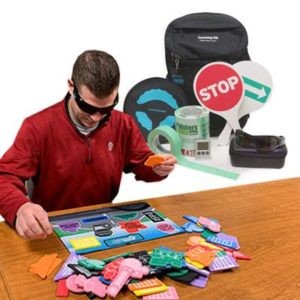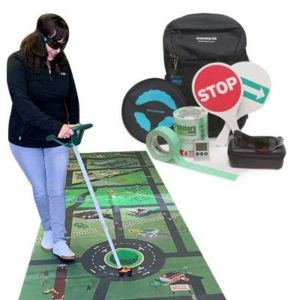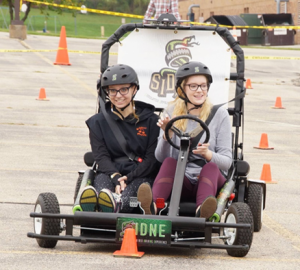
Distracted Driving Education and Awareness Initiatives
Teaching new drivers the dangers of distracted driving can help them understand why focusing on the road is so important. Teaching young or new drivers about the dangers of distracted

You’ve probably heard about the dangers of driving while under the influence of alcohol and drugs. But did you know that drowsy driving—driving while sleepy or worn out—can have a similar impact on your ability to drive safely? The National Highway Traffic Safety Administration (NHTSA) estimates that in 2017, 91,000 crashes involved drowsy drivers.
Keep reading to learn more about the dangers of distracted and drowsy driving, and how educators can implement drowsy driving prevention programs to reduce the number of drowsy driving accidents.
Whatever the reason—a new baby, a lengthy road trip, a sleep disorder, or even everyday stress—fatigue impacts us all at one time or another and in different ways. Fatigue can also lead to deadly consequences on the road.
There are varying statistics on how many crashes occur due to drowsy driving because it can be difficult to determine whether a driver was fatigued at the time of the crash. The NHTSA estimates that accidents involving a tired driver killed 800 people in 2017 and injured another 50,000, though many experts believe those numbers could be much higher.
Drowsy driving is not uncommon. The Centers for Disease Control and Prevention (CDC) found a third of U.S. adults report getting less than the recommended seven hours of sleep. And approximately 1 out of 25 adults reported having fallen asleep while driving within the 30 days before being surveyed.
Some people experience micro-sleeps, or short periods of inattention that may last just a few seconds but have dangerous outcomes.
Driving drowsy doesn’t necessarily mean falling fast asleep behind the wheel. Drowsy driving can also make you less attentive, slow down your reaction time, and affect your ability to make decisions.
Studies have shown that going too long without sleep can impair your ability to drive in similar ways to drunk driving. Being awake for 24 hours or more is equal to having a blood alcohol content (BAC) of 0.10%—higher than the legal BAC limit in all states.
Here are some signs that it’s time to pull over, from the National Sleep Foundation:
You can do plenty of things to reduce drowsy driving even before you get behind the wheel:
Many drivers likely don’t understand the impact of driving while tired or distracted. That’s why hands-on learning tools and experiences are essential to any drowsy driving prevention and awareness program.
Our distracted driving simulators provide a safe and realistic way to learn about a hazardous situation, allowing participants to see what it’s like to have delayed reaction time and other impairments.
Fatal Vision Drowsy and Distracted Goggles simulate momentary micro-sleeps that build in waves until the eyes and brain shut down. The goggles black out, beginning with a short half-second closure and continue to black out for longer periods, to mimic the process of nodding off while driving.
Whichever tools you use, the goal is to help reinforce the dangers of drowsy driving and help reduce preventable crashes.
Have questions? Our team of experts is here to help you find the right tools for your drowsy driving prevention program. Contact us online or call 800.272.5023 today.
7 Top Tools for Distracted & Drowsy Driving Prevention
With over twenty years of experience, we have a full lineup of distracted and drowsy driving tools that can be a game-changer in your awareness and prevention program.
 7 Questions to Ask Before Buying a Distracted Driving Simulator
7 Questions to Ask Before Buying a Distracted Driving Simulator
If you’re in the market for a distracted driving simulator, there are several factors to consider when making a purchasing decision. Consider asking the following questions to help ensure you make a wise investment.
11 Considerations When Buying a Texting & Driving Simulator 
Experiencing first-hand the hazards of distracted driving within a safe, controlled environment can help educate drivers about these dangers.
Innocorp is the pioneering developer of Fatal Vision® Goggles and other experiential learning tools designed to educate on the dangers of impairment and promote risk prevention. Innocorp provides impactful, hands-on resources used globally by law enforcement, educators, and safety professionals to demonstrate the consequences of substance use, risky driving, and other dangerous behaviors.
We’d love to online chat! We are available Monday-Friday from 8am-5pm (CST):
Or schedule a time for a consultation:

Teaching new drivers the dangers of distracted driving can help them understand why focusing on the road is so important. Teaching young or new drivers about the dangers of distracted

Set your students up for success by utilizing the full driving safety toolkit available. Driving safety is an important part of any student or young adult education course. Safety

Knowing the dangers and causes of drowsy driving is key for students and young adults to take the risks seriously. Driving while fatigued is a serious issue that poses
CUSTOMER SUPPORT
Buy America Act
Contact
GSA Customers
Returns
Shipping
Warranties
My Account
Login
Create an Account
INNOCORP HEADQUARTERS
500 S Nine Mound Road
P.O. Box 930064
Verona, WI 53593-0064
800-272-5023 Mon-Fri 8-5 CT
608-848-5558 Fax
©2025 Innocorp. All Rights Reserved